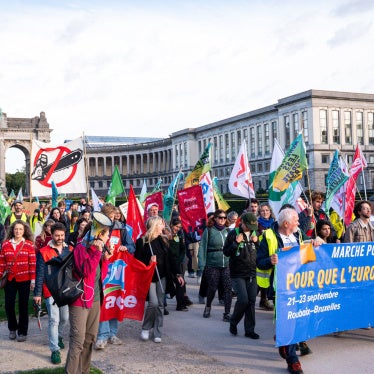Comments on Overarching Human Rights Provisions
in the World Bank’s Environmental and Social Framework
March 15, 2016
The Coalition welcomes this opportunity to comment on the World Bank’s proposed Environmental and Social Framework (ESF). In this submission we encourage the World Bank to amend the ESF to meaningfully address human rights. We have highlighted in previous submissions why this is so important and have additionally put forward detailed policy recommendations addressing the overarching architecture of the ESF as well as the various Environmental and Social Standards (ESSs). We will not repeat those here. Instead, we focus on the overarching human rights provisions of the ESF.
We do, however, wish to take this opportunity to express our disappointment that Bank management has not yet played a leadership role in advancing this issue. After the World Bank and 193 countries committed to a global agenda for sustainable development that is centered on the protection of human rights, it is incumbent upon the Bank to take this issue forward not backward.
The World Bank has increasingly asserted that development assistance can be more effective if it works more directly with the institutions and systems that countries already have in place and supports efforts to strengthen those institutions and systems. A key element of this is respecting a country’s human rights obligations, including by not supporting activities that contravene these obligations. In doing so, the Bank would support governments in fulfilling their treaty obligations and promote policy harmonization within governments, as well as reduce the burden on governments of having to comply with a multiplicity of standards. As the World Bank and Organisation for Economic Co-operation and Development (OECD) have noted, more and more donors are implementing human rights policies.
Finally, as we see increasing incidences of development activities feeding into conflict and leading to violent attacks on environmental and human rights defenders, including the killing this month of indigenous leader Berta Cáceres, it is critical that the Bank give an unequivocal signal that human rights related risks and impacts must be identified and addressed. Instead the language in the current draft suggests that human rights related risks and impacts are at best peripheral and at worst, outside the range of inquiry and examination. It does not serve the Bank or its clients to ignore the greatest risks to project sustainability and development effectiveness.
In this limited submission, we 1) respond to arguments that have been put forward by the safeguards team for not embracing human rights language in the ESF, and 2) put forward recommendations for modest revisions to the existing draft to ensure that human rights risks and impacts are addressed.
I. Responses to the World Bank’s Arguments for not Embracing Human Rights
The safeguards team has suggested that it is not appropriate to require the Bank or its borrowers to respect human rights because to do so would risk the World Bank becoming a human rights tribunal. This is not the case. For years, the Bank has been required to comply with international environmental law, yet it has not raised concerns about becoming an environmental tribunal. We emphasize that our recommendations, outlined below, are strictly focused on project affected areas and do not ask the Bank or borrower to address human rights issues beyond those areas. Rather than itself becoming a tribunal, implementing the below recommendations would require the World Bank to take into account the rich jurisprudence of human rights tribunals and the guidance that they have developed just as the Bank takes into account risk information from other expert bodies.
The safeguards team additionally has argued that human rights norms cannot be referenced within the text because not all of the Bank’s member States have ratified all of the human rights treaties. There are however, fundamental norms of customary law which bind all nations, regardless of the treaties they have ratified. Additionally, at time of writing, more than 90 percent of the World Bank’s 188 member countries have ratified four or more of the core international human rights treaties. All but two have ratified the International Convention on the Rights of the Child; 181 have ratified the International Convention on the Elimination of All Forms of Discrimination against Women; 171 have ratified the International Convention on the Elimination of All Forms of Racial Discrimination; 163 have ratified the International Covenant on Civil and Political Rights; and 160 have ratified the International Covenant on Economic, Social and Cultural Rights. All of the 187 member states of the International Labour Organization (ILO) have accepted the ILO Declaration on Fundamental Principles and Rights at Work and committed themselves to respect and promote the fundamental rights therein. Human rights are also protected to varying degrees in most countries’ constitutions or legislation.
The safeguards team has also contended that they have integrated within the ESF the human rights principles of participation, non-discrimination, transparency and accountability, and that this is sufficient. But these principles are only one piece of the human rights framework. To support the realization of human rights, these principles are intended to go hand in hand with substantive human rights. For example, the prohibition against discrimination within human rights treaties relates to the obligation of governments to respect and ensure the rights recognized within those treaties. Integrating these principles without requiring respect of human rights or tracking existing human rights norms is grossly insufficient. Further, as discussed below with respect to non-discrimination, these principles are not adequately integrated within the proposed ESF.
The safeguards team has also asserted that they do not want to refer to external standards, such as the ILO core labor standards, because they want the framework to stand on its own. Good, properly implemented standards all over the world, be they national law or other IFI standards, include such references to international standards. The IFC’s Performance Standards and the existing World Bank safeguards both do so.
II. Recommended Amendments to the Draft Environmental and Social Framework
(a) Include a commitment to respect human rights within the operative text
Amend paragraph 2 of the Environmental and Social Policy, to include a new sentence, using one of the language alternatives presented below:
The Bank will respect human rights throughout its operations and take all necessary/reasonable measures to ensure that the activities it finances or otherwise supports do not [cause or contribute to human rights violations][have a negative impact on human rights][violate human rights].
(b) Ensure that human rights risks and impacts are accounted for in the definition of social risks and impacts
Amend paragraph 4(b) of the Environmental and Social Policy, to either:
- Amend (vi) to read “impacts on human health, rights, safety and well-being of workers and project-affected communities”; or
- Insert at the end of the paragraph, “(viii) any other human rights related risks or impacts.”
(c) Ensure that the Environmental and Social Framework is backed up with robust due diligence requirements that are able to effectively address human rights related risks
Amend paragraph 30 of the Environmental and Social Policy, to:
- Delete the reference to “as appropriate”;
- Amend (a) to explicitly recognize that the Bank’s due diligence responsibilities will include “reviewing and identifying the information provided by the Borrower…” and “conducting additional research where there are gaps that prevent the Bank from completing its due diligence”;
- Insert a new subsection, outlining that the Bank’s due diligence responsibilities will include “reviewing the Systematic Country Diagnostic, applicable legal framework, and implementation practices, track record, commitment and capacity of the Borrower”;
- Specify that the Bank’s responsibility to provide guidance “to assist the Borrower in developing appropriate measures consistent with the mitigation hierarchy to address environmental and social risks and impacts” must be “in compliance with international law” as well as “in accordance with the ESSs”;
- Specify that “the Bank is responsible for verifying that the information provided is adequate and sufficient for the Bank to fulfill its responsibility to undertake environmental and social due diligence in accordance with this Policy.”
(d) Strengthen the objectives of the Environmental and Social Standards (ESSs) so that they reflect the substance of the ESSs, in particular the objective to do no harm and of non-discrimination
Amend the objectives of Environmental and Social Standard 1 to commit to not harming communities and not discriminating against marginalized individuals and groups. Appropriate language can be drawn from paragraph 5 of the Vision Statement. Without this language, preventing discrimination would be absent from the objectives, meaning that it would not be required in the use of country systems and co-financing common approaches:
- To design and implement effective sustainable development activities in compliance with international law, and responsive to the development priorities and needs of local communities;
- To ensure that there is no prejudice or discrimination toward project-affected individuals or communities, particularly in the case of disadvantaged or vulnerable groups, in the distribution of adverse impacts or in access to development resources and project benefits; and
Amend the existing objective on the mitigation hierarchy to focus on producing specific results, particularly not harming communities or the environment, rather than merely adopting an approach, and ensuring that harms are fully remedied:
- To identify, evaluate and manage the environmental and social risks and impacts of the project
in a manner consistent with the ESSsso as to ensure thatadopt a mitigation hierarchy approach to:
Anticipate and avoid risks andadverse social and environmental risks and impacts are anticipated and avoided;- Where avoidance is not possible,
minimize or reducerisks and impacts are minimized or reduced to acceptable levels; - Once risks and impacts have been minimized or reduced, they are mitigated; and
- Where residual risks or impacts remain, they are remedied, including through compensation
for or offset them, where technically and financially feasible.
(e) Remove the inconsistency between the assessment of national and international law in ESS1
Amend paragraph 24 of ESS1 to remove the inconsistency between how national and international legal obligations are to be assessed by deleting “directly” before “applicable to the project under relevant international treaties and agreements”.
(f) Remedy the problems with the aspirational language in the Vision Statement
Amend the problematic language in paragraph 3 of the Vision Statement to address the following concerns, using the language from the first draft ESF as the starting point since the current/2nd draft is fundamentally flawed:
- If the framework refers to only one human rights instrument, it should be clear that this is not exhaustive;
- Human rights should be characterized as binding legal obligations, not mere aspirations;
- Paragraph 9 already invokes the Articles of Agreement. The additional and unique reference to the Articles in relation to human rights implies that human rights may be outside or limited by the Articles, which is not the case.
Proposed amendments:
The Bank recognizes the importance of human rights, including those articulated in the Universal Declaration of Human Rights, for helping to ensure development effectiveness. In this regard, the World Bank [is responsible for ensuring][is responsible for undertaking all reasonable measures to ensure][will ensure] that its operations do not [have a negative impact on][violate human rights] or contravene borrowers’ [obligations][commitments] under international law, including by undertaking necessary due diligence in the design and implementation of the development projects that it supports.








